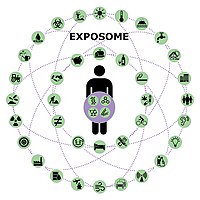
Photo from wikipedia
In aquatic ecosystems, the biocide triclosan represents a hazard for the non-target microalgae. So far, algal responses were mainly investigated at apical levels hampering the acquisition of a holistic view… Click to show full abstract
In aquatic ecosystems, the biocide triclosan represents a hazard for the non-target microalgae. So far, algal responses were mainly investigated at apical levels hampering the acquisition of a holistic view on primary, adaptive, and compensatory stress responses. We assessed responses of the chlorophyte Scenedesmus vacuolatus to triclosan at apical (growth, photosynthesis) and molecular (transcriptome, metabolome) levels for comparative pathway sensitivity analysis. For each responsive signal (contigs, metabolites), a concentration-response curve was modeled and effect concentrations were calculated leading to the setting of cumulative sensitivity distributions. Molecular responses showed higher sensitivity than apical observations. The functional annotation of contigs and metabolites revealed 118 metabolic pathways putatively impaired by triclosan, highlighting a wide repercussion on the algal metabolism. Metabolites involved in the lipid metabolism showed decreasing trends along the concentration gradient and a globally highest sensitivity, pointing to the primary target of triclosan. The pathways involved in xenobiotic degradation and membrane transporters were mainly regulated in the transcriptome with increasing response trends comprising compensatory responses. The suggested novel approach, combining apical and multi-omics analyses in a concentration-response framework improves mechanistic understanding and mode of action analysis on non-targeted organisms and is suggested to better implement high-throughput multi-omics data in environmental risk assessment.
Journal Title: Journal of hazardous materials
Year Published: 2020
Link to full text (if available)
Share on Social Media: Sign Up to like & get
recommendations!